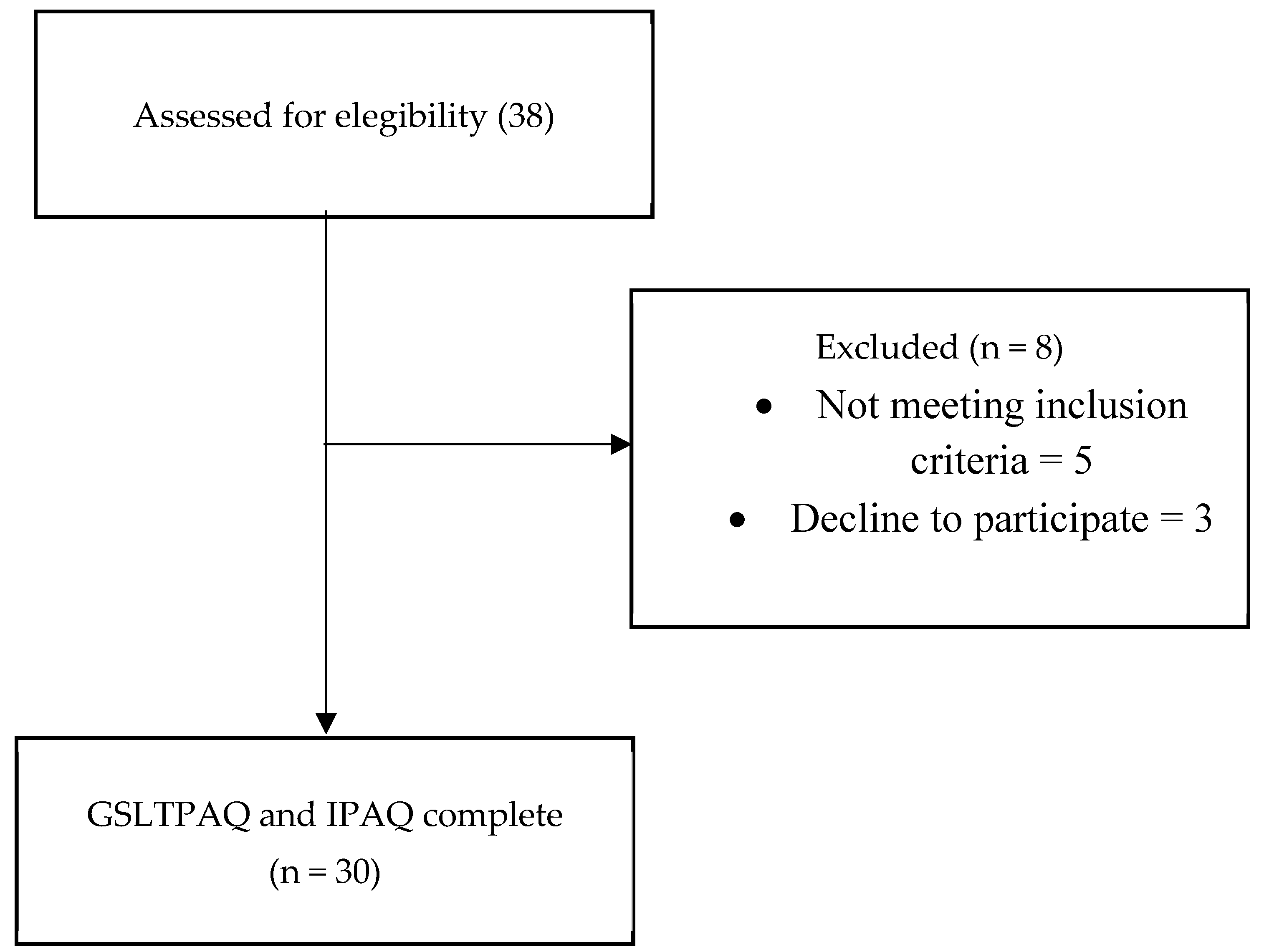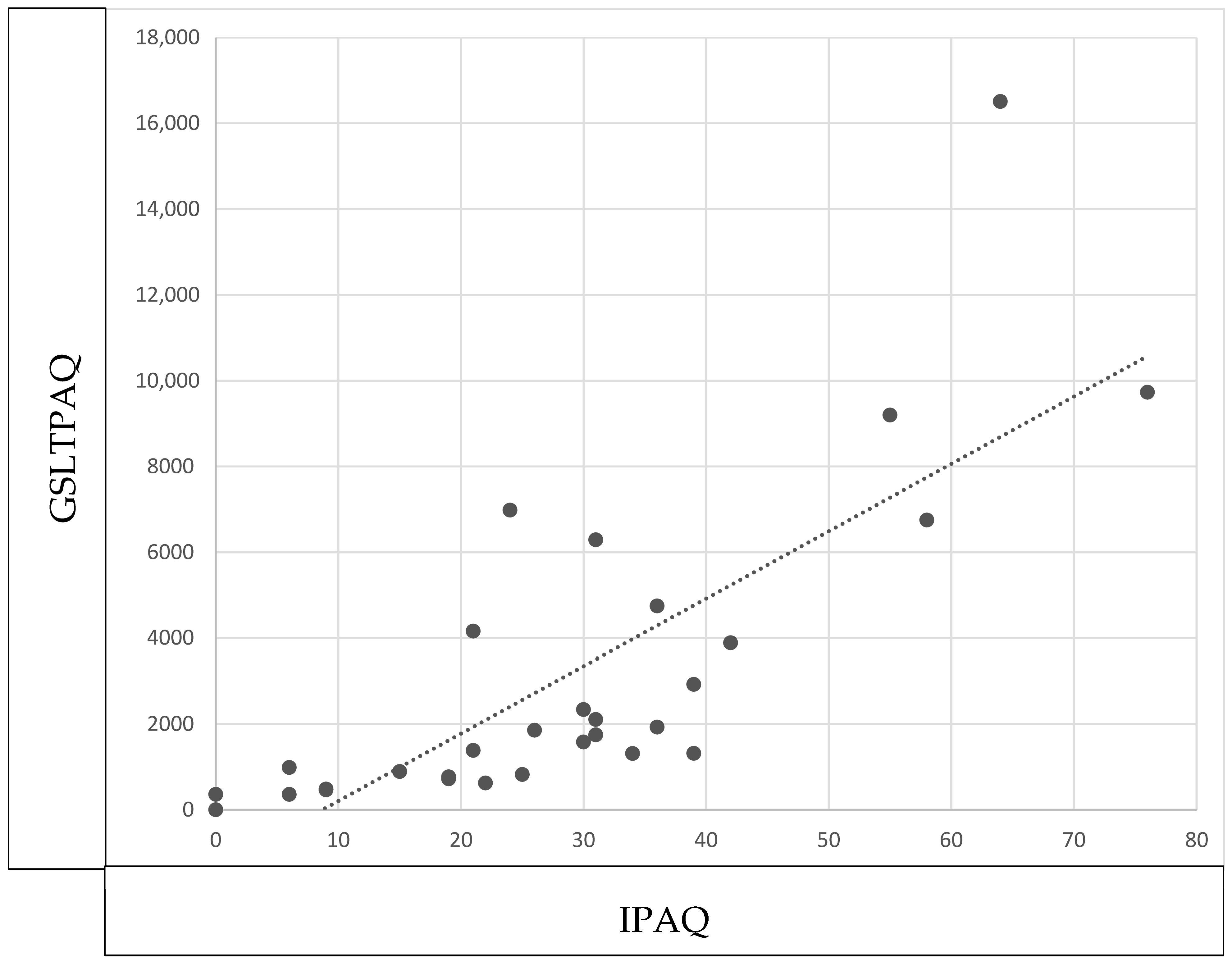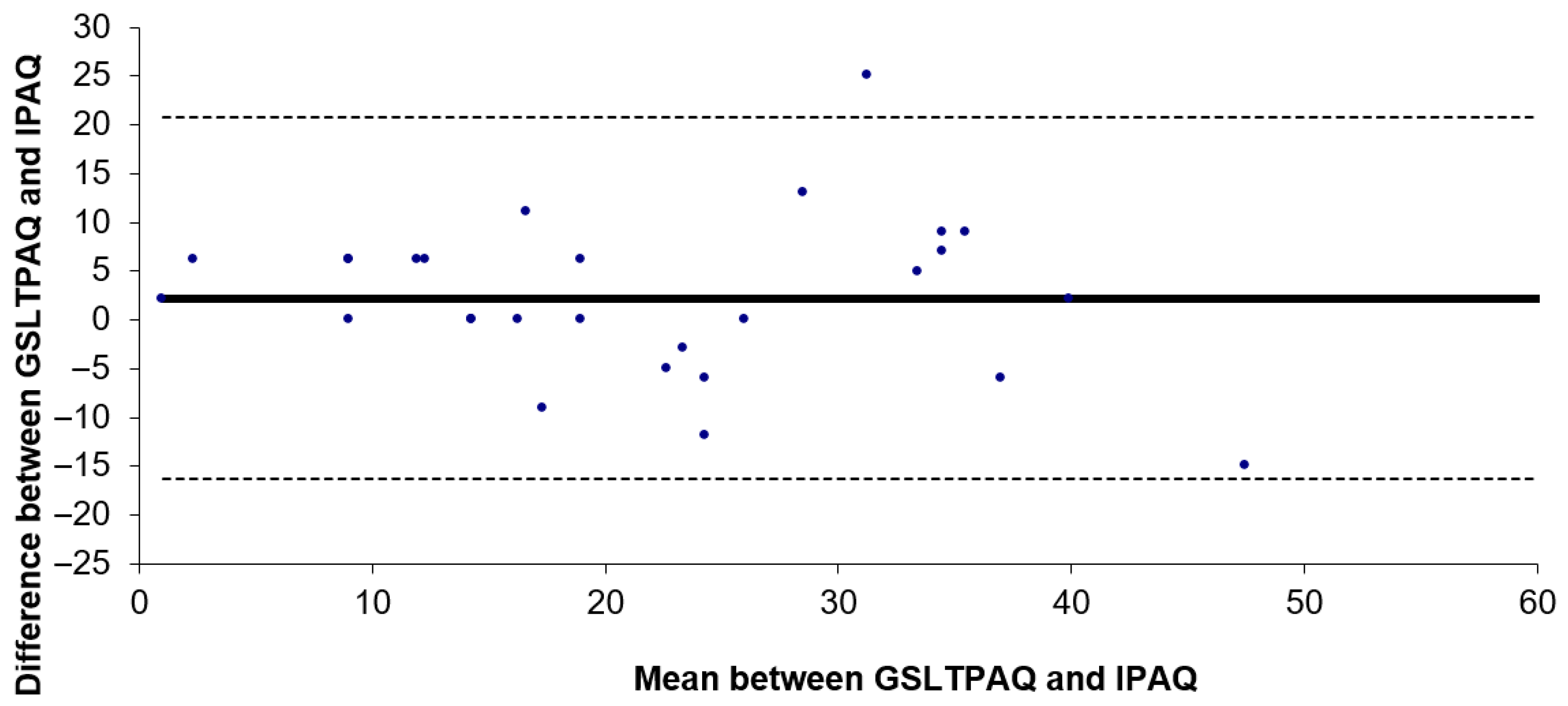Validity and Reliability of the Spanish Version of Godin-Shephard Leisure-Time Physical Activity Questionnaire in Prostate Cancer Patients
Abstract
1. Introduction
2. Methods
2.1. Questionnaire
2.2. Part 1: Translation and Cross-Cultural Adaption
2.3. Part 2: Evaluation of Psychometric Properties of the GSLTPAQ
2.4. Protocol
2.5. Statical/Data Analysis
3. Results
3.1. Construct Validity
3.2. Internal Consistency
3.3. Test-Retest Reliability
4. Discussion
5. Limitations
6. Conclusions
Supplementary Materials
Author Contributions
Funding
Institutional Review Board Statement
Informed Consent Statement
Data Availability Statement
Conflicts of Interest
References
- Sociedad Española de Oncología Médica (SEOM). Las Cifras del Cáncer en España 2023. Inf. SEOM 2023. Available online: https://seom.org/prensa/el-cancer-en-cifras (accessed on 20 November 2024).
- Keogh, J.W.; MacLeod, R.D. Body composition, physical fitness, functional performance, quality of life, and fatigue benefits of exercise for prostate cancer patients: A systematic review. J. Pain Symptom Manag. 2012, 43, 96–110. [Google Scholar] [CrossRef] [PubMed]
- Vashistha, V.; Singh, B.; Kaur, S.; Prokop, L.J.; Kaushik, D. The effects of exercise on fatigue, quality of life, and psychological function for men with prostate cancer: Systematic review and meta-analyses. Eur. Urol. Focus 2016, 2, 284–295. [Google Scholar] [CrossRef] [PubMed]
- Al-Majid, S.; Gray, D.P. A biobehavioral model for the study of exercise interventions in cancer-related fatigue. Biol. Res. Nurs. 2009, 10, 381–391. [Google Scholar] [CrossRef] [PubMed]
- Friedenreich, C.M.; Wang, Q.; Neilson, H.K.; Kopciuk, K.A.; McGregor, S.E.; Courneya, K.S. Physical activity and survival after prostate cancer. Eur. Urol. 2016, 70, 576–585. [Google Scholar] [CrossRef]
- Galvão, D.A.; Taaffe, D.R.; Spry, N.; Newton, R.U. Exercise can prevent and even reverse adverse effects of androgen suppression treatment in men with prostate cancer. Prostate Cancer Prostatic Dis. 2007, 10, 340–346. [Google Scholar] [CrossRef]
- Forbes, C.C.; Blanchard, C.M.; Mummery, W.K.; Courneya, K.S. A comparison of physical activity preferences among breast, prostate, and colorectal cancer survivors in Nova Scotia, Canada. J. Phys. Act. Health 2015, 12, 823–833. [Google Scholar] [CrossRef] [PubMed]
- Buffart, L.M.; Kalter, J.; Sweegers, M.G.; Courneya, K.S.; Newton, R.U.; Aaronson, N.K.; Brug, J. Effects and moderators of exercise on quality of life and physical function in patients with cancer: An individual patient data meta-analysis of 34 RCTs. Cancer Treat. Rev. 2017, 52, 91–104. [Google Scholar] [CrossRef]
- Sattar, S.; Haase, K.R.; Bradley, C.; Papadopoulos, E.; Kuster, S.; Santa Mina, D.; Alibhai, S. Barriers and facilitators related to undertaking physical activities among men with prostate cancer: A scoping review. Prostate Cancer Prostatic Dis. 2021, 24, 1007–1027. [Google Scholar] [CrossRef] [PubMed]
- Schmitz, K.; Courneya, K.S.; Matthews, C. American College of Sports Medicine roundtable on exercise guidelines for cancer survivors. Med. Sci. Sports Exerc. 2010, 42, 1409–1426. [Google Scholar] [CrossRef] [PubMed]
- Amireault, S.; Godin, G.; Lacombe, J.; Sabiston, C.M. Validation of the Godin-Shephard Leisure-Time Physical Activity Questionnaire classification coding system using accelerometer assessment among breast cancer survivors. J. Cancer Surviv. 2015, 9, 532–540. [Google Scholar] [CrossRef]
- Amireault, S.; Godin, G.; Lacombe, J.; Sabiston, C.M. The use of the Godin-Shephard Leisure-Time Physical Activity Questionnaire in oncology research: A systematic review. BMC Med. Res. Methodol. 2015, 15, 60. [Google Scholar] [CrossRef] [PubMed]
- Ruiz-Casado, A.; Alejo, L.B.; Santos-Lozano, A.; Soria, A.; Ortega, M.J.; Pagola, I.; Fiuza-Luces, C.; Palomo, I.; Garatachea, N.; Cebolla, H.; et al. Validity of the Physical Activity Questionnaires IPAQ-SF and GPAQ for cancer survivors: Insights from a Spanish cohort. Int. J. Sports Med. 2016, 37, 979–985. [Google Scholar] [CrossRef] [PubMed]
- Craig, C.L.; Marshall, A.L.; Sjöström, M.; Bauman, A.E.; Booth, M.L.; Ainsworth, B.E.; Pratt, M.; Ekelund, U.L.F.; Yngve, A.; Sallis, J.F.; et al. International physical activity questionnaire: 12-country reliability and validity. Med. Sci. Sports Exerc. 2003, 35, 1381–1395. [Google Scholar] [CrossRef] [PubMed]
- Godin, G. The Godin-Shephard leisure-time physical activity questionnaire. Health Fitness J. Can. 2011, 4, 18–22. [Google Scholar]
- Liu, R.D.; Buffart, L.M.; Kersten, M.J.; Spiering, M.; Brug, J.; van Mechelen, W.; Chinapaw, M.J. Psychometric properties of two physical activity questionnaires, the AQuAA and the PASE, in cancer patients. BMC Med. Res. Methodol. 2011, 11, 30. [Google Scholar] [CrossRef] [PubMed]
- Terwee, C.B.; Prinsen, C.A.; Chiarotto, A.; Westerman, M.J.; Patrick, D.L.; Alonso, J.; Bouter, L.M.; De Vet, H.C.; Mokkink, L.B. COSMIN methodology for evaluating the content validity of patient-reported outcome measures: A Delphi study. Qual. Life Res. 2018, 27, 1159–1170. [Google Scholar] [CrossRef]
- Grossman, P.; Deuring, G.; Garland, S.N.; Campbell, T.S.; Carlson, L.E. Patterns of objective physical functioning and perception of mood and fatigue in posttreatment breast cancer patients and healthy controls: An ambulatory psychophysiological investigation. Psychosom. Med. 2008, 70, 819–828. [Google Scholar] [CrossRef]
- Tillmann, V.; Darlington, A.S.; Eiser, C.; Bishop, N.J.; Davies, H.A. Male sex and low physical activity are associated with reduced spine bone mineral density in survivors of childhood acute lymphoblastic leukemia. J. Bone Miner. Res. 2002, 17, 1073–1080. [Google Scholar] [CrossRef] [PubMed]
- Godin, G.; Shephard, R.J. A simple method to assess exercise behavior in the community. Can. J. Appl. Sport Sci. 1985, 10, 141–146. [Google Scholar] [PubMed]
- Lee, P.H.; Macfarlane, D.J.; Lam, T.H.; Stewart, S.M. Validity of the International Physical Activity Questionnaire Short Form (IPAQ-SF): A systematic review. Int. J. Behav. Nutr. Phys. Act. 2011, 8, 115. [Google Scholar] [CrossRef]
- Beaton, D.E.; Bombardier, C.; Guillemin, F.; Ferraz, M.B. Guidelines for the process of cross-cultural adaptation of self-report measures. Spine 2000, 25, 3186–3191. [Google Scholar] [CrossRef] [PubMed]
- Wright, A.A.; Abbott, J.H.; Baxter, D.; Cook, C. The ability of a sustained within-session finding of pain reduction during traction to dictate improved outcomes from a manual therapy approach on patients with osteoarthritis of the hip. J. Man. Manip. Ther. 2010, 18, 166–172. [Google Scholar] [CrossRef] [PubMed]
- Hulley, S.B.; Cummings, S.R.; Browner, W.S.; Grady, D.; Newman, T.B. Designing Clinical Research: An Epidemiologic Approach, 4th ed.; Lippincott Williams & Wilkins: Philadelphia, PA, USA, 2013; Appendix 6C; p. 79. [Google Scholar]
- Prince, S.A.; LeBlanc, A.G.; Colley, R.C.; Saunders, T.J. Measurement of sedentary behaviour in population health surveys: A review and recommendations. PeerJ 2017, 5, e4130. [Google Scholar] [CrossRef] [PubMed]
- Terwee, C.B.; Bot, S.D.; de Boer, M.R.; Van der Windt, D.A.; Knol, D.L.; Dekker, J.; Bouter, L.M.; de Vet, H.C. Quality criteria were proposed for measurement properties of health status questionnaires. J. Clin. Epidemiol. 2007, 60, 34–42. [Google Scholar] [CrossRef]
- Koo, T.K.; Li, M.Y. A guideline of selecting and reporting intraclass correlation coefficients for reliability research. J. Chiropr. Med. 2016, 15, 155–163. [Google Scholar] [CrossRef]
- McGraw, K.O.; Wong, S.P. Forming inferences about some intraclass correlation coefficients. Psychol. Methods 1996, 1, 30. [Google Scholar] [CrossRef]
- Bland, J.M.; Altman, D.G. Statistical methods for assessing agreement between two methods of clinical measurement. Lancet 1986, 1, 307–310. [Google Scholar] [CrossRef] [PubMed]
- Perna, F.M.; Craft, L.; Freund, K.M.; Skrinar, G.; Stone, M.; Kachnic, L.; Youren, C.; Battaglia, T.A. The effect of a cognitive behavioral exercise intervention on clinical depression in a multiethnic sample of women with breast cancer: A randomized controlled trial. Int. J. Sport Exerc. Psychol. 2010, 8, 36–47. [Google Scholar] [CrossRef]
- Bonn, S.E.; Sjölander, A.; Lagerros, Y.T.; Wiklund, F.; Stattin, P.; Holmberg, E.; Grönberg, H.; Bälter, K. Physical activity and survival among men diagnosed with prostate cancer. Cancer Epidemiol. Biomarkers Prev. 2015, 24, 57–64. [Google Scholar] [CrossRef] [PubMed]
- Helmerhorst, H.J.; Brage, S.; Warren, J.; Besson, H.; Ekelund, U. A systematic review of reliability and objective criterion-related validity of physical activity questionnaires. Int. J. Behav. Nutr. Phys. Act. 2012, 9, 103. [Google Scholar] [CrossRef] [PubMed]
- Network, S.B.R. Letter to the Editor: Standardized use of the terms “sedentary” and “sedentary behaviours”. Appl. Physiol. Nutr. Metab. 2012, 37, 540–542. [Google Scholar]
- Greenland, S. Dose–response and trend analysis in epidemiology: Alternatives to categorical analysis. Epidemiology 1995, 6, 356–365. [Google Scholar] [CrossRef] [PubMed]
- Motl, R.W.; Bollaert, R.E.; Sandroff, B.M. Validation of the Godin Leisure-Time Exercise Questionnaire classification coding system using accelerometry in multiple sclerosis. Rehabil. Psychol. 2018, 63, 77–82. [Google Scholar] [CrossRef]
- João, T.M.S.; Rodrigues, R.C.M.; Gallani, M.C.B.J.; Miura, C.T.P.; Domingues, G.D.B.L.; Amireault, S.; Godin, G. Validity of the Brazilian version of the Godin-Shephard Leisure-Time Physical Activity Questionnaire. Cad. Saude Publica 2015, 31, 1825–1838. [Google Scholar] [CrossRef] [PubMed]



| Characteristics | Cancer Patients (n = 30) |
|---|---|
| Age (y) | 69.47 ± 5.34 |
| BMI (kg/cm2) | 28.01 ± 4.15 |
| Charlson Index | 6; 2–9 |
| PSA | 7.07 ± 6.28 |
| Gleason Score | 7.30 ± 1.08 |
| Cancer Stage | 2; 1–4 |
| T | 2; 0–4 |
| N | 0.0; 0–1 |
| M | 0.0; 0–1 |
| Measures | Cancer Patients (n = 30) |
|---|---|
| GSLTPAQ light (1) | 15 (0–21) kcal/kg/week |
| GSLTPAQ moderate (1) | 2.50 (0–25) kcal/kg/week |
| GSLTPAQ vigorous (1) | 0.00 (0–45) kcal/kg/week |
| GSLTPAQ total (1) | 28 (0–76) kcal/kg/week |
| GSLTPAQ light (2) | 15 (3–21) kcal/kg/week |
| GSLTPAQ moderate (2) | 2.50 (0–35) kcal/kg/week |
| GSLTPAQ vigorous (2) | 0.00 (0–36) kcal/kg/week |
| GSLTPAQ total (2) | 30.50 (2–86) kcal/kg/week |
| IPAQ light | 1170.4 ± 230.1 MET·min/week |
| IPAQ moderate | 822.0 ± 407.2 MET·min/week |
| IPAQ vigorous | 1130.6 ± 354.0 MET·min/week |
| IPAQ total | 3107.0 ± 671.4 MET·min/week |
Disclaimer/Publisher’s Note: The statements, opinions and data contained in all publications are solely those of the individual author(s) and contributor(s) and not of MDPI and/or the editor(s). MDPI and/or the editor(s) disclaim responsibility for any injury to people or property resulting from any ideas, methods, instructions or products referred to in the content. |
© 2025 by the authors. Licensee MDPI, Basel, Switzerland. This article is an open access article distributed under the terms and conditions of the Creative Commons Attribution (CC BY) license (https://creativecommons.org/licenses/by/4.0/).
Share and Cite
Martín Núñez, J.; Valenza, M.C.; Heredia Ciuró, A.; Calvache Mateo, A.; Navas Otero, A.; Blasco Valls, P.; Reychler, G. Validity and Reliability of the Spanish Version of Godin-Shephard Leisure-Time Physical Activity Questionnaire in Prostate Cancer Patients. Healthcare 2025, 13, 154. https://doi.org/10.3390/healthcare13020154
Martín Núñez J, Valenza MC, Heredia Ciuró A, Calvache Mateo A, Navas Otero A, Blasco Valls P, Reychler G. Validity and Reliability of the Spanish Version of Godin-Shephard Leisure-Time Physical Activity Questionnaire in Prostate Cancer Patients. Healthcare. 2025; 13(2):154. https://doi.org/10.3390/healthcare13020154
Chicago/Turabian StyleMartín Núñez, Javier, Marie Carmen Valenza, Alejandro Heredia Ciuró, Andrés Calvache Mateo, Alba Navas Otero, Paula Blasco Valls, and Gregory Reychler. 2025. "Validity and Reliability of the Spanish Version of Godin-Shephard Leisure-Time Physical Activity Questionnaire in Prostate Cancer Patients" Healthcare 13, no. 2: 154. https://doi.org/10.3390/healthcare13020154
APA StyleMartín Núñez, J., Valenza, M. C., Heredia Ciuró, A., Calvache Mateo, A., Navas Otero, A., Blasco Valls, P., & Reychler, G. (2025). Validity and Reliability of the Spanish Version of Godin-Shephard Leisure-Time Physical Activity Questionnaire in Prostate Cancer Patients. Healthcare, 13(2), 154. https://doi.org/10.3390/healthcare13020154






